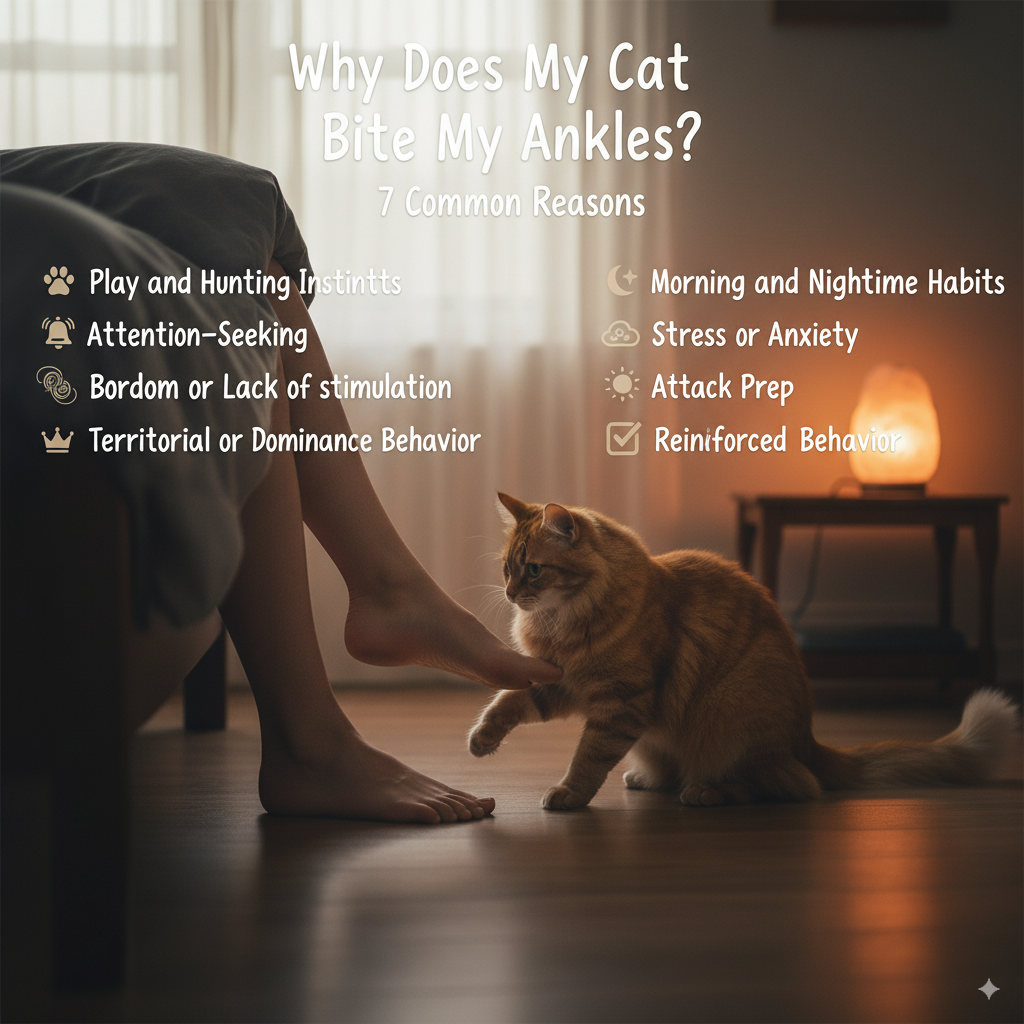Post Disclaimer
Catopedea shares information for educational and general interest purposes only. Our content is not a substitute for professional veterinary advice, diagnosis, or treatment. Always consult a licensed veterinarian for concerns about your cat’s health, diet, or behavior.
If you’re a cat owner, you’ve probably experienced the sudden nip at your ankles while walking across the room. Sometimes it’s playful, other times it’s surprising – and if it happens often, it can quickly turn from funny to frustrating.
So why do cats bite ankles? The reasons range from natural hunting instincts to boredom, attention-seeking, or even stress. The good news is that in most cases, it’s not aggression – it’s communication. Understanding what drives the behavior is the first step to stopping it.
In this guide, we’ll break down common reasons cats bite ankles, plus practical solutions you can use right away.

1. Play and Hunting Instincts
Cats are born hunters. Your moving ankles resemble prey – making them irresistible targets.
- Kittens and young cats are the biggest culprits.
- Pouncing and ankle-biting mimic the “stalk and catch” sequence.
- Lack of other hunting outlets makes your feet the next best thing.
How to Stop It: Schedule two daily play sessions with wand toys or lasers. Rotate toys to keep things interesting. ASPCA notes that play is essential enrichment for indoor cats.
2. Attention-Seeking
If your cat wants you to notice them, a quick ankle bite is hard to ignore.
- Cats learn what gets a reaction.
- They may use biting as a way to “call you back” if you’re walking away.
How to Stop It: Ignore the bite. Walk away calmly and give attention only when your cat is calm. Reward good behavior with play or treats.
3. Boredom or Lack of Stimulation
Indoor cats without enough outlets often create their own games – and your ankles are easy targets.
- Ankle-biting relieves pent-up energy.
- Boredom-driven biting often happens at predictable times (morning or evening).
How to Stop It:
- Add puzzle feeders for mental stimulation.
- Provide scratching posts and cat trees.
- Rotate climbing and interactive toys to keep them fresh.
(Related: Cat Trees for Large Cats – Best Towers & Condos)
4. Territorial or Dominance Behavior
Some cats bite ankles to control space or herd their humans.
- This is more common in multi-cat homes.
- It can look like play but feels firmer and more insistent.
How to Stop It: Create clear boundaries. Redirect with play instead of punishment. Give each cat their own territory (beds, scratching posts, perches).
5. Stress or Anxiety
Cats under stress sometimes channel nervous energy into ankle-biting.
- Common triggers: moving homes, new pets, loud noises, or routine changes.
- Stress-related bites may be paired with hiding or over-grooming.
How to Stop It: Provide safe spaces (cozy cat beds, quiet rooms). Try pheromone diffusers like Feliway. Minimize sudden changes when possible.
(Related: Why Is My Cat Growling Suddenly?)
6. Morning and Nighttime Habits
Cats are crepuscular – most active at dawn and dusk.
- Morning ankle-biting may be a breakfast request.
- Nighttime bites often signal a desire for play.
How to Stop It:
- Feed a small meal before bed.
- Tire your cat out with evening play sessions.
- Consider an automatic feeder for early mornings.
7. Reinforced Behavior
Sometimes ankle-biting persists simply because it worked in the past.
- If you laughed, scolded, or even picked them up, your cat got attention.
- Cats repeat behaviors that lead to interaction.
How to Stop It: Break the cycle. Don’t reward ankle-biting. Give attention only after calm or positive behavior.
Medical or Pain-Related Causes (Less Common)
A sudden change in biting habits may point to discomfort.
- Pain, arthritis, or illness can alter behavior.
- A cat that never bit before but suddenly starts may be signaling distress.
How to Stop It: Rule out medical causes. If ankle-biting is sudden, intense, or paired with other symptoms, consult a vet. Cornell Feline Health Center stresses monitoring sudden behavioral changes closely.
Habit From Kittenhood
Kittens often play-bite siblings. If not redirected early, this habit can carry into adulthood – with ankles taking the place of littermates.
How to Stop It: Redirect kittens to toys from the start. Avoid rough play with hands or feet.
How to Stop Cats From Biting Ankles
If your cat has turned your feet into their favorite target, don’t worry — this behavior can usually be redirected with consistency and the right strategies. Here are some practical steps you can start using today:
1. Redirect with Toys
Cats bite ankles because they need an outlet for hunting energy. Instead of punishing them, redirect that instinct to appropriate toys.
- Use wand toys, laser pointers, or rolling balls to simulate hunting.
- Rotate toys every few days so your cat doesn’t get bored.
- Keep a toy nearby when walking through the house — if your cat starts to stalk your feet, toss the toy ahead to redirect their chase.
Why it works: Your cat still gets to practice “stalking and pouncing,” but in a way that doesn’t involve your ankles.
2. Set Playtime Routines
Cats thrive on routine. A 10–15 minute play session before meals or bedtime not only burns energy but also satisfies their natural hunting cycle.
- Try playing before breakfast so they’re less likely to ambush your ankles in the morning.
- A nighttime play session helps them sleep when you do, instead of zooming around and nipping at your feet.
- End play with a small meal or treat to mimic the hunt–catch–eat cycle.
Why it works: It replaces ankle-biting habits with a predictable, rewarding schedule.
3. Provide Enrichment
Indoor cats, in particular, need plenty of mental and physical stimulation. Without it, they’ll invent their own games — like attacking your ankles.
- Add scratching posts, cat trees, and tunnels to create climbing and exploring opportunities.
- Puzzle feeders give them both food and mental challenge.
- Window perches let them watch birds or outdoor activity safely.
Why it works: A stimulated cat is less likely to chase your ankles out of boredom.
(Related: Cat Trees for Large Cats – Best Towers & Condos)
4. Ignore Ankle Bites
It’s tempting to shout or chase your cat away, but any attention — even negative — can reinforce the behavior.
- When bitten, stop walking and stand still, or calmly walk away without reacting.
- Avoid yelling, clapping, or physical corrections. These can make the behavior worse.
- Consistency is key — if you ignore bites every time, your cat will learn it doesn’t get them what they want.
Why it works: Cats quickly drop behaviors that no longer bring attention or reward.
5. Reward Positive Behavior
Cats learn best when they’re rewarded for doing the right thing.
- Keep treats handy. If your cat approaches without biting, reward them immediately.
- Praise calm behavior — gentle rubs, slow blinks, or sitting nicely instead of attacking.
- Combine treats with toys to create positive reinforcement loops.
Why it works: Over time, your cat learns that calm engagement gets them what they want, while biting ankles doesn’t.
6. Consult a Vet or Behaviorist
If the biting becomes intense or persists despite your efforts, it may be time to seek help.
- A vet can rule out pain, illness, or other health triggers that could cause biting.
- A feline behaviorist can design a custom plan tailored to your cat’s personality and environment.
Why it works: Sometimes ankle-biting is more than play getting professional advice ensures you address the root cause.
How to Stop Cats From Biting Ankles
If your cat has turned your feet into their favorite target, don’t worry – this behavior can usually be redirected with consistency and the right strategies. Here are some practical steps you can start using today:
1. Redirect with Toys
Cats bite ankles because they need an outlet for hunting energy. Instead of punishing them, redirect that instinct to appropriate toys.
- Use wand toys, laser pointers, or rolling balls to simulate hunting.
- Rotate toys every few days so your cat doesn’t get bored.
- Keep a toy nearby when walking through the house – if your cat starts to stalk your feet, toss the toy ahead to redirect their chase.
Why it works: Your cat still gets to practice “stalking and pouncing,” but in a way that doesn’t involve your ankles.
2. Set Playtime Routines
Cats thrive on routine. A 10-15 minute play session before meals or bedtime not only burns energy but also satisfies their natural hunting cycle.
- Try playing before breakfast so they’re less likely to ambush your ankles in the morning.
- A nighttime play session helps them sleep when you do, instead of zooming around and nipping at your feet.
- End play with a small meal or treat to mimic the hunt-catch-eat cycle.
Why it works: It replaces ankle-biting habits with a predictable, rewarding schedule.
3. Provide Enrichment
Indoor cats, in particular, need plenty of mental and physical stimulation. Without it, they’ll invent their own games – like attacking your ankles.
- Add scratching posts, cat trees, and tunnels to create climbing and exploring opportunities.
- Puzzle feeders give them both food and mental challenge.
- Window perches let them watch birds or outdoor activity safely.
Why it works: A stimulated cat is less likely to chase your ankles out of boredom.
(Related: Cat Trees for Large Cats – Best Towers & Condos)
4. Ignore Ankle Bite
It’s tempting to shout or chase your cat away, but any attention – even negative – can reinforce the behavior.
- When bitten, stop walking and stand still, or calmly walk away without reacting.
- Avoid yelling, clapping, or physical corrections. These can make the behavior worse.
- Consistency is key – if you ignore bites every time, your cat will learn it doesn’t get them what they want.
Why it works: Cats quickly drop behaviors that no longer bring attention or reward.
5. Reward Positive Behavior
Cats learn best when they’re rewarded for doing the right thing.
- Keep treats handy. If your cat approaches without biting, reward them immediately.
- Praise calm behavior – gentle rubs, slow blinks, or sitting nicely instead of attacking.
- Combine treats with toys to create positive reinforcement loops.
Why it works: Over time, your cat learns that calm engagement gets them what they want, while biting ankles doesn’t.
6. Consult a Vet or Behaviorist
If the biting becomes intense or persists despite your efforts, it may be time to seek help.
- A vet can rule out pain, illness, or other health triggers that could cause biting.
- A feline behaviorist can design a custom plan tailored to your cat’s personality and environment.
Why it works: Sometimes ankle-biting is more than play – getting professional advice ensures you address the root cause.
When to Worry
Most ankle-biting is harmless and tied to play or attention-seeking. However, there are times when it could signal something more serious. Keep an eye out for these warning signs:
- It starts suddenly in an older cat.
Sudden behavior changes may point to discomfort, illness, or stress. Cats are masters at hiding pain, so ankle-biting could be their way of expressing unease. - The biting becomes frequent, intense, or aggressive.
Playful nips are usually gentle. If the bites are hard, accompanied by scratching, or happen constantly, it may be a sign of frustration or underlying behavioral issues. - It’s paired with growling, hissing, or fear behaviors.
Aggression combined with vocal warnings suggests stress, fear, or a territorial response rather than simple play.
If you notice any of these patterns, don’t ignore them. Schedule a vet visit to rule out health problems, and consider consulting a feline behaviorist for tailored guidance. VCA Animal Hospitals recommends monitoring any sudden changes closely, as they’re often the earliest signs of stress or medical concerns.
Frequently Asked Questions
Why does my cat randomly bite my ankles?
Usually play, boredom, or attention-seeking.
Do cats grow out of ankle-biting?
Yes, many cats reduce biting with age – especially if redirected early.
Why does my cat bite my ankles in the morning?
They may be hungry or trying to wake you.
Can ankle-biting be a sign of stress?
Yes, especially if your cat also hides, over-grooms, or seems restless.
How do I stop my cat from biting feet at night?
Play before bedtime, feed a late snack, and redirect with toys.
Conclusion
Ankle-biting may be annoying, but it’s rarely about aggression. In most cases, it’s your cat’s way of playing, asking for attention, or following natural instincts. With enrichment, routine play, and consistency, you can redirect the behavior into healthier outlets.
Remember – cats are quick learners. With patience and the right strategies, you’ll soon have a calmer, happier cat (and bite-free ankles).
(Also read: Why Does My Cat Stare at Me While I Sleep? | Cat Eye Language: Understanding Feline Emotions)


